Ben-Hur: A Tale of the Christ (Fred Niblo, 1925) is one of the very best Hollywood films of the silent era. Years in the making, with filming in Italy and California, and changes of script and leading man, the monumental film could have been a disaster. Instead, it was a complete triumph and established MGM as a studio to be reckoned with. Star was the young and handsome Ramon Novarro, who portrayed a charismatic and sympathetic Ben-Hur. Why his revealing costumes caused a sensation at the time, you can see on the beautiful sepia postcards in this post by a.o. Ross Verlag of Germany, Iris-Verlag of Austria and Editions Cinémagazine of France.

Austrian postcard by Iris Verlag, no. 715/4. Photo: MGM. Publicity still for Ben-Hur: A Tale of the Christ (Fred Niblo, 1925) with Ramon Novarro and Claire McDowell.
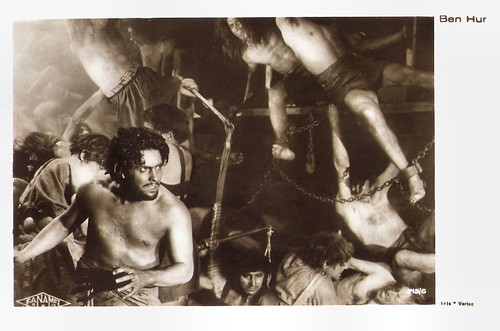
Austrian postcard by Iris Verlag, no. 715/6. Photo: FaNaMet. Publicity still for Ben-Hur: A Tale of the Christ (Fred Niblo, 1925).
Ramon Novarro (also Ramón Novarro) plays in Ben-Hur: A Tale of the Christ (Fred Niblo, 1925) the Jewish prince Judah Ben-Hur, who seeks to find his family and to revenge himself upon his boyhood friend, the powerful Roman Tribune Messala (Francis X. Bushman) who had him wrongly imprisoned.
After an accident, a slip of a brick during a Roman parade, Messala, who has become corrupt and arrogant, makes sure Ben-Hur and his family are jailed and separated. Judah is sent off as a galley slave, his property confiscated and his mother (Claire McDowell) and sister are imprisoned.
Ben-Hur is sentenced to slave labour in a Roman war galley. Along the way, he unknowingly encounters Jesus, the carpenter's son who offers him water. Once aboard ship, his attitude of defiance and strength impresses a Roman admiral, Quintus Arrius (Frank Currier), who allows him to remain unchained. This actually works in the Admiral's favour because when his ship is attacked and sunk by pirates, Ben-Hur saves him from drowning. Years later, as a result of his determination to stay alive and his willingness to aid his Roman master, Judah returns to his homeland an exalted and wealthy Roman athlete.
Unable to find his mother and sister, and believing them dead, he can think of nothing else than revenge against Messala. This eventually leads to a climactic showdown with Messala in a chariot race, in which Ben-Hur is the victor. Ben-Hur is eventually reunited with his mother and sister, who are suffering from leprosy but are miraculously cured by Jesus.
Ben-Hur was Ramon Novarro's greatest success. He was promoted by MGM as a 'Latin lover' and became known as sex symbol after the death of Rudolph Valentino. His revealing costumes in Ben-Hur: A Tale of the Christ helped to establish this image.
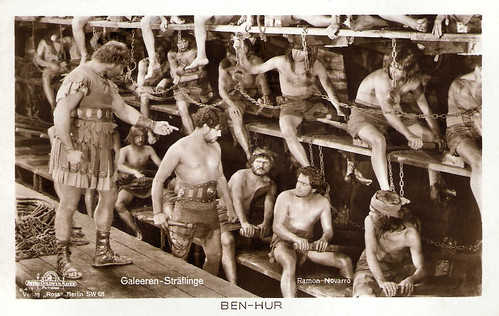
German postcard by Ross Verlag, Berlin, no. 64/1. Photo: Metro-Goldwyn-Mayer (MGM) / Fanamet. Publicity still for Ben-Hur: A Tale of the Christ (Fred Niblo, 1925). Caption: 'Galeeren-Sträflinge' (convicts).
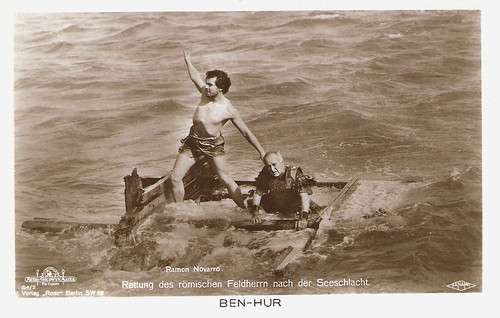
German postcard by Ross Verlag, Berlin, no. 64/2. Photo: MGM / FaNaMet. Publicity still for Ben-Hur: A Tale of the Christ (Fred Niblo, 1925) with Ramon Novarro and Frank Currier. Caption: Rescue of the Roman general after the sea battle.
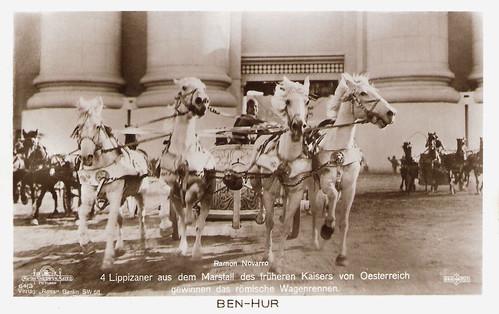
German postcard by Ross Verlag, Berlin, no. 64/3. Photo: MGM / ParUfaMet. Publicity still for Ben-Hur: A Tale of the Christ (Fred Niblo, 1925). Caption: 4 Lipizzaner stallions from the stables of the former Emperor of Austria to win the Roman chariot races.

German postcard by Ross Verlag, Berlin, no. 64/7. Photo: Metro-Goldwyn-Mayer. Publicity still for Ben-Hur (Fred Niblo, 1925) with Carmel Myers.
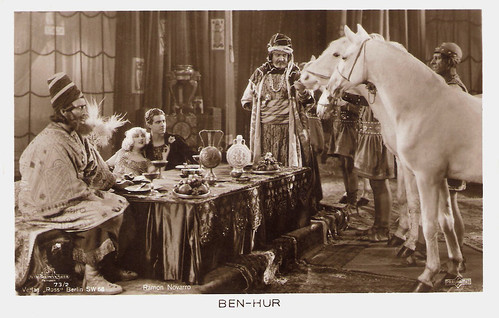
German postcard by Ross Verlag, no. 73/2. Photo: MGM / ParUfaMet. Publicity still for Ben-Hur: A Tale of the Christ (Fred Niblo, 1925) with Carmel Myers and Ramon Novarro.
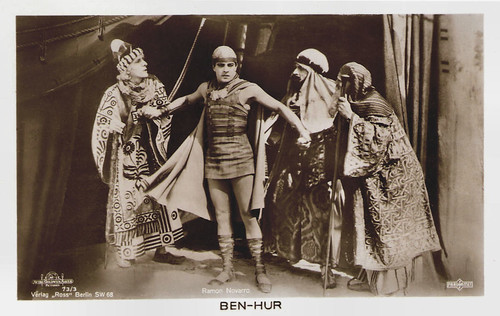
German postcard by Ross Verlag, Berlin, no. 73/3. Photo: MGM / ParUfaMet. Publicity still for Ben-Hur: A Tale of the Christ (Fred Niblo, 1925).

German postcard by Ross Verlag, Berlin, no. 73/4. Photo: MGM / ParUfaMet. Publicity still for Ben-Hur: A Tale of the Christ (Fred Niblo, 1925). Ramon Novarro (or his double?) leading the chariot.
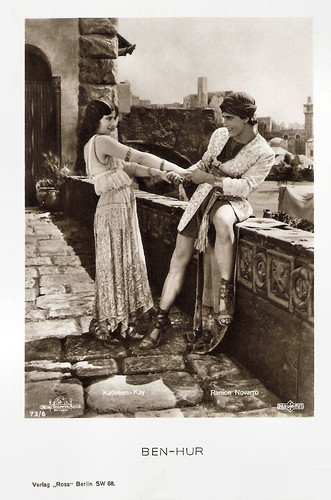
German postcard by Ross Verlag, Berlin, no. 73/6. Photo: MGM / ParUfaMet. Publicity still for Ben-Hur: A Tale of the Christ (Fred Niblo, 1925) with Kathleen Kay and Ramon Novarro.
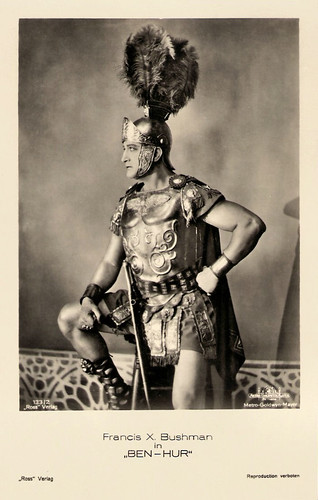
German postcard by Ross-Verlag, no. 133/2. Photo: Metro-Goldwyn-Mayer. Publicity still for Ben-Hur (Fred Niblo, 1925) with Francis X. Bushman.
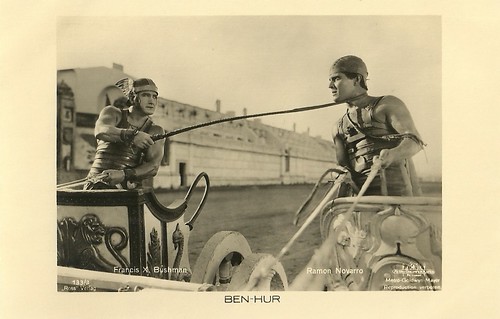
German postcard by Ross-Verlag, no. 133/3. Photo: Metro-Goldwyn-Mayer. Publicity still for Ben-Hur (Fred Niblo, 1925) with Messala (Francis X. Bushman) and Ben-Hur (Ramon Novarro) during the famous chariot race. Mark how the tribunes are empty and the upper part of the circus is missing (it was projected into the film using a hanging model).

German postcard by Ross-Verlag, no. 133/6. Photo: Metro-Goldwyn-Mayer. Publicity still for Ben-Hur (Fred Niblo, 1925) with Carmel Myers and Ramon Novarro.
The film is based on the 1880 novel Ben-Hur: A Tale of the Christ by Lew Wallace. The novel was a great success. It was adapted into a stage play which ran for twenty-five years. The novel was first adapted for the screen in 1907 also titled Ben Hur.
In 1922, two years after the play's last tour, the Goldwyn company purchased the film rights to Ben-Hur. The play's producer, Abraham Erlanger, put a heavy price on the screen rights. Erlanger was persuaded to accept a generous profit participation deal and total approval over every detail of the production.
Shooting began in Rome, Italy in October 1923 under the direction of Charles Brabin who was replaced shortly after filming began. Additional recastings (including Ramón Novarro as Ben-Hur) and a change of director caused the production's budget to skyrocket.
After two years of difficulties and accidents, the production was eventually moved back to Metro-Goldwyn-Mayer in Culver City, California and production resumed in the spring of 1925. B. Reeves Eason and Christy Cabanne directed the second unit footage.
Costs eventually rose to $3.9 million, making Ben-Hur one of the most expensive films of the silent era.
A total of 60,960 m (200,000 ft) of film was shot for the chariot race scene, which was eventually edited down to 229 m (750 ft). Film critic Kevin Brownlow has called the chariot race sequence as creative and influential a piece of cinema as the famous Odessa Steps sequence in Sergei M. Eisenstein's Bronenosets Potemkin/The Battleship Potemkin (1925), which introduced modern concepts of film editing and montage to cinema.
This scene has been much imitated. It was re-created virtually shot for shot in the remake, Ben-Hur (William Wyler, 1959), copied in the animated film The Prince of Egypt (Brenda Chapman, Steve Hickner, Simon Wells, 1998), and imitated in the pod race scene in the Star Wars Episode I: The Phantom Menace (George Lucas, 1999), which was made almost 75 years later.
Some scenes in the film were in two-colour Technicolor, most notably the sequences involving Jesus. One of the assistant directors for this sequence was a very young William Wyler, who would direct the 1959 remake. The black-and-white footage was colour tinted and toned in the film's original release print.

French postcard by Editions Cinematographiques, no. 9. Photo: MGM. Publicity still for Ben-Hur: A Tale of the Christ (Fred Niblo, 1925) with Ramon Novarro and Francis X. Bushman.
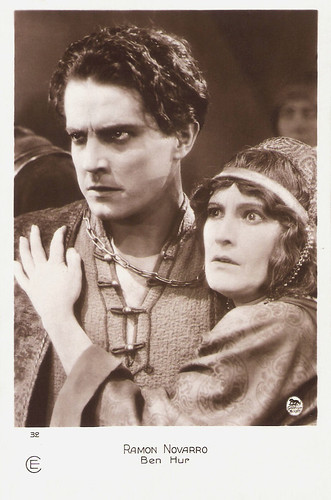
French postcard by Editions Cinematographiques, no. 32. Photo: MGM. Publicity still for Ben-Hur: A Tale of the Christ (Fred Niblo, 1925) with Ramon Novarro and Claire McDowell.

French postcard by Cinemagazine-Edition, Paris, no. 36. Photo: Metro-Goldwyn-Mayer (MGM). Publicity still for Ben-Hur: A Tale of the Christ (Fred Niblo, 1925) with Ramon Novarro and Frank Currier.
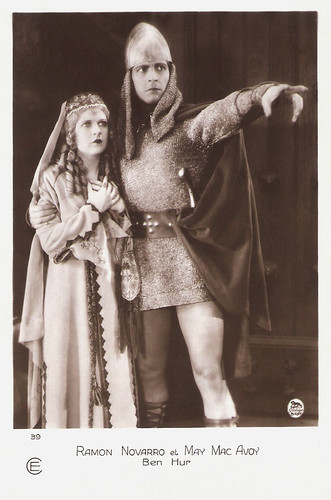
French postcard by Editions Cinematographiques, no. 39. Photo: MGM. Publicity still for Ben-Hur: A Tale of the Christ (Fred Niblo, 1925) with Ramon Novarro and May McAvoy.
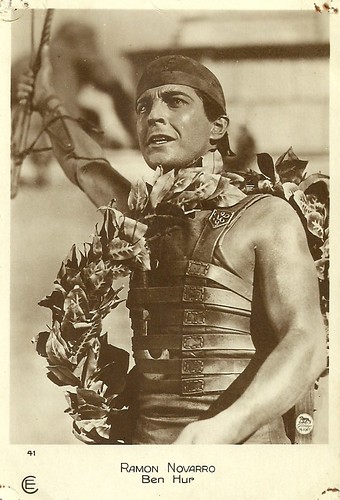
French postcard by Editions Cinémagazine, no. 41. Photo: Metro-Goldwyn-Mayer. Publicity still for Ben-Hur: A Tale of the Christ (Fred Niblo, 1925) with Ramon Novarro.
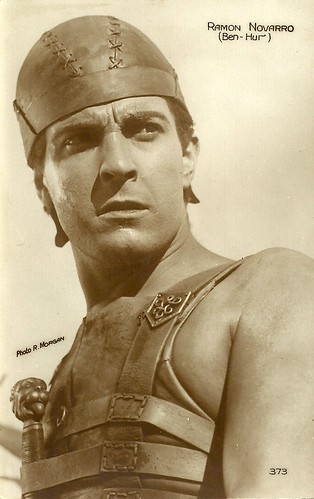
French postcard by Editions Cinémagazine, no. 373. Photo: R. Morgan. Publicity still for Ben-Hur: A Tale of the Christ (Fred Niblo, 1925) with Ramon Novarro.
Brian J. Smith at IMDb: "The 1925 version of Ben-Hur is an outstanding example of silent film making at it's best. With the proverbial cast of thousands, it compares favourably with it's more expensive and lavish 1959 remake. Had the Academy Awards been given out at this time, Ben-Hur would undoubtedly have won it's share.
The video version that I saw was restored to it's original splendour complete with tints and two colour technicolor sequences. They are quite spectacular and hold up quite well today. The birth of Christ sequence is most memorable. The flagship sequences, the sea battle and the chariot race, are expertly staged and remain the most exciting parts of the picture. They are as good as those in the 1959 version.
The casting is, for the most part, excellent. Ramon Novarro as Judah and Francis X. Bushman as Messala stand out. The only problem is the casting of May McAvoy as Esther. With her blond hair, blue eyes and riglets, she looks more like a Mary Pickford want to be than a Jewish slave girl. Despite all of it's well documented production problems, Ben-Hur still is one of the best movies of all time, silent or sound."
Ben Burgraff at IMDb: "With the record number of Oscars won by the William Wyler 1959 version of BEN-HUR, there is a tendency to overlook the monumental 1925 production. Well, if you've never seen the earlier version, you may be in for a surprise...it is superior in nearly every way!
Certainly, some of the performances (particularly Francis X. Bushman's scenery-chewing Messala) are cartoonish, the film lacks the widescreen splendour and scope of it's successor, and the 'Wyler Touch', the infinite care the legendary director poured over every detail, is sorely missed. But there is an energy and sense of intimacy in Fred Niblo's version that is sorely lacking in the later version; the film, as a whole, is far closer in spirit to General Lew Wallace's novel; and young leading man Ramon Novarro (with a sexy intensity reminiscent of Tyrone Power), makes a far more charismatic and sympathetic Ben-Hur than Charlton Heston.
The 1925 version's chariot race is equally as exciting, and the sea battle used full-sized ships and hundreds of extras (shot in Italy, where a fire broke out on the ships during the shooting...the extras' panic on screen was NOT acting!) With two-strip Technicolor to emphasise key scenes (the Nativity, the new Roman Consul's arrival in Jerusalem...yes, those ARE topless women leading the procession!), and a wonderful, stirring new musical score by Carl Davis, Fred Niblo's BEN-HUR is a treasure, a film you'll want to see again and again."
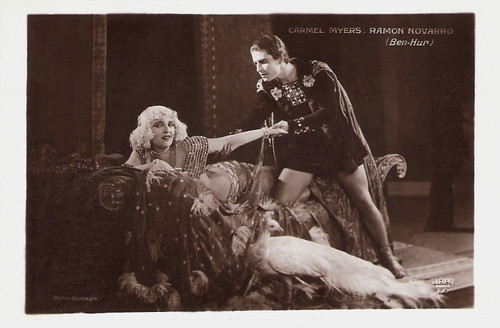
French postcard by J.R.P.R, Paris. no. 69. Photo: MGM. Publicity still for Ben-Hur: A Tale of the Christ (Fred Niblo, 1925) with Ramon Novarro and Carmel Myers.
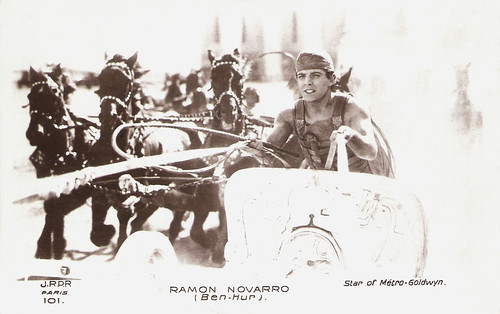
French postcard by J.R.P.R., Paris, no. 101. Photo: MGM. Publicity still for Ben-Hur: A Tale of the Christ (Fred Niblo, 1925).

French postcard for the Cinéma Madeleine, Paris. Photo: Metro-Goldwyn-Mayer. The Roman fleet in Ben-Hur: A Tale of the Christ (Fred Niblo, 1925), shot in the Mediterranean near Livorno, Italy.
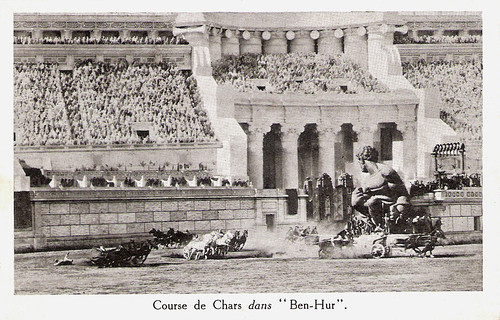
French postcard for the Cinema Madeleine, Paris. Photo: publicity still for Ben-Hur: A Tale of the Christ (Fred Niblo, 1925). Capture: Chariot race in Ben-Hur.
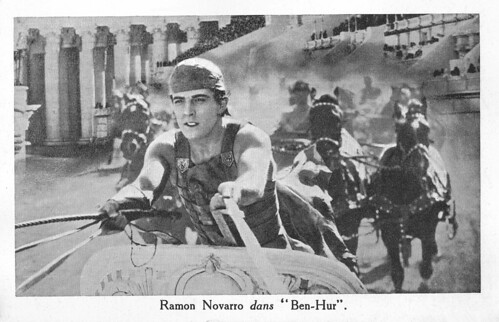
French postcard by Cinema Madeleine, Paris. Photo: publicity still for Ben-Hur: A Tale of the Christ (Fred Niblo, 1925).
At the moment Hollywood works on a new version, Ben-Hur (2016). Director is Timur Bekmambetov, the Russian-Kazakh film director known for vampire franchise Nochnoy dozor/Night Watch (2004) and Dnevnoy dozor/Night Chat (2006). The title role will be played by British actor Jack Huston, and other roles are for Danish actor Pilou Asbæk, Dutch actor Marwan Kenzari and Morgan Freeman. And Rodrigo Santoro plays Jesus.
And here at EFSP, we will do a post on Ramon Novarro on 20 January 2016.
Sources: Wikipedia and IMDb.

Austrian postcard by Iris Verlag, no. 715/4. Photo: MGM. Publicity still for Ben-Hur: A Tale of the Christ (Fred Niblo, 1925) with Ramon Novarro and Claire McDowell.

Austrian postcard by Iris Verlag, no. 715/6. Photo: FaNaMet. Publicity still for Ben-Hur: A Tale of the Christ (Fred Niblo, 1925).
Revenge
Ramon Novarro (also Ramón Novarro) plays in Ben-Hur: A Tale of the Christ (Fred Niblo, 1925) the Jewish prince Judah Ben-Hur, who seeks to find his family and to revenge himself upon his boyhood friend, the powerful Roman Tribune Messala (Francis X. Bushman) who had him wrongly imprisoned.
After an accident, a slip of a brick during a Roman parade, Messala, who has become corrupt and arrogant, makes sure Ben-Hur and his family are jailed and separated. Judah is sent off as a galley slave, his property confiscated and his mother (Claire McDowell) and sister are imprisoned.
Ben-Hur is sentenced to slave labour in a Roman war galley. Along the way, he unknowingly encounters Jesus, the carpenter's son who offers him water. Once aboard ship, his attitude of defiance and strength impresses a Roman admiral, Quintus Arrius (Frank Currier), who allows him to remain unchained. This actually works in the Admiral's favour because when his ship is attacked and sunk by pirates, Ben-Hur saves him from drowning. Years later, as a result of his determination to stay alive and his willingness to aid his Roman master, Judah returns to his homeland an exalted and wealthy Roman athlete.
Unable to find his mother and sister, and believing them dead, he can think of nothing else than revenge against Messala. This eventually leads to a climactic showdown with Messala in a chariot race, in which Ben-Hur is the victor. Ben-Hur is eventually reunited with his mother and sister, who are suffering from leprosy but are miraculously cured by Jesus.
Ben-Hur was Ramon Novarro's greatest success. He was promoted by MGM as a 'Latin lover' and became known as sex symbol after the death of Rudolph Valentino. His revealing costumes in Ben-Hur: A Tale of the Christ helped to establish this image.

German postcard by Ross Verlag, Berlin, no. 64/1. Photo: Metro-Goldwyn-Mayer (MGM) / Fanamet. Publicity still for Ben-Hur: A Tale of the Christ (Fred Niblo, 1925). Caption: 'Galeeren-Sträflinge' (convicts).

German postcard by Ross Verlag, Berlin, no. 64/2. Photo: MGM / FaNaMet. Publicity still for Ben-Hur: A Tale of the Christ (Fred Niblo, 1925) with Ramon Novarro and Frank Currier. Caption: Rescue of the Roman general after the sea battle.

German postcard by Ross Verlag, Berlin, no. 64/3. Photo: MGM / ParUfaMet. Publicity still for Ben-Hur: A Tale of the Christ (Fred Niblo, 1925). Caption: 4 Lipizzaner stallions from the stables of the former Emperor of Austria to win the Roman chariot races.

German postcard by Ross Verlag, Berlin, no. 64/7. Photo: Metro-Goldwyn-Mayer. Publicity still for Ben-Hur (Fred Niblo, 1925) with Carmel Myers.

German postcard by Ross Verlag, no. 73/2. Photo: MGM / ParUfaMet. Publicity still for Ben-Hur: A Tale of the Christ (Fred Niblo, 1925) with Carmel Myers and Ramon Novarro.

German postcard by Ross Verlag, Berlin, no. 73/3. Photo: MGM / ParUfaMet. Publicity still for Ben-Hur: A Tale of the Christ (Fred Niblo, 1925).

German postcard by Ross Verlag, Berlin, no. 73/4. Photo: MGM / ParUfaMet. Publicity still for Ben-Hur: A Tale of the Christ (Fred Niblo, 1925). Ramon Novarro (or his double?) leading the chariot.

German postcard by Ross Verlag, Berlin, no. 73/6. Photo: MGM / ParUfaMet. Publicity still for Ben-Hur: A Tale of the Christ (Fred Niblo, 1925) with Kathleen Kay and Ramon Novarro.

German postcard by Ross-Verlag, no. 133/2. Photo: Metro-Goldwyn-Mayer. Publicity still for Ben-Hur (Fred Niblo, 1925) with Francis X. Bushman.

German postcard by Ross-Verlag, no. 133/3. Photo: Metro-Goldwyn-Mayer. Publicity still for Ben-Hur (Fred Niblo, 1925) with Messala (Francis X. Bushman) and Ben-Hur (Ramon Novarro) during the famous chariot race. Mark how the tribunes are empty and the upper part of the circus is missing (it was projected into the film using a hanging model).

German postcard by Ross-Verlag, no. 133/6. Photo: Metro-Goldwyn-Mayer. Publicity still for Ben-Hur (Fred Niblo, 1925) with Carmel Myers and Ramon Novarro.
Two years of difficulties and accidents
The film is based on the 1880 novel Ben-Hur: A Tale of the Christ by Lew Wallace. The novel was a great success. It was adapted into a stage play which ran for twenty-five years. The novel was first adapted for the screen in 1907 also titled Ben Hur.
In 1922, two years after the play's last tour, the Goldwyn company purchased the film rights to Ben-Hur. The play's producer, Abraham Erlanger, put a heavy price on the screen rights. Erlanger was persuaded to accept a generous profit participation deal and total approval over every detail of the production.
Shooting began in Rome, Italy in October 1923 under the direction of Charles Brabin who was replaced shortly after filming began. Additional recastings (including Ramón Novarro as Ben-Hur) and a change of director caused the production's budget to skyrocket.
After two years of difficulties and accidents, the production was eventually moved back to Metro-Goldwyn-Mayer in Culver City, California and production resumed in the spring of 1925. B. Reeves Eason and Christy Cabanne directed the second unit footage.
Costs eventually rose to $3.9 million, making Ben-Hur one of the most expensive films of the silent era.
A total of 60,960 m (200,000 ft) of film was shot for the chariot race scene, which was eventually edited down to 229 m (750 ft). Film critic Kevin Brownlow has called the chariot race sequence as creative and influential a piece of cinema as the famous Odessa Steps sequence in Sergei M. Eisenstein's Bronenosets Potemkin/The Battleship Potemkin (1925), which introduced modern concepts of film editing and montage to cinema.
This scene has been much imitated. It was re-created virtually shot for shot in the remake, Ben-Hur (William Wyler, 1959), copied in the animated film The Prince of Egypt (Brenda Chapman, Steve Hickner, Simon Wells, 1998), and imitated in the pod race scene in the Star Wars Episode I: The Phantom Menace (George Lucas, 1999), which was made almost 75 years later.
Some scenes in the film were in two-colour Technicolor, most notably the sequences involving Jesus. One of the assistant directors for this sequence was a very young William Wyler, who would direct the 1959 remake. The black-and-white footage was colour tinted and toned in the film's original release print.

French postcard by Editions Cinematographiques, no. 9. Photo: MGM. Publicity still for Ben-Hur: A Tale of the Christ (Fred Niblo, 1925) with Ramon Novarro and Francis X. Bushman.

French postcard by Editions Cinematographiques, no. 32. Photo: MGM. Publicity still for Ben-Hur: A Tale of the Christ (Fred Niblo, 1925) with Ramon Novarro and Claire McDowell.

French postcard by Cinemagazine-Edition, Paris, no. 36. Photo: Metro-Goldwyn-Mayer (MGM). Publicity still for Ben-Hur: A Tale of the Christ (Fred Niblo, 1925) with Ramon Novarro and Frank Currier.

French postcard by Editions Cinematographiques, no. 39. Photo: MGM. Publicity still for Ben-Hur: A Tale of the Christ (Fred Niblo, 1925) with Ramon Novarro and May McAvoy.

French postcard by Editions Cinémagazine, no. 41. Photo: Metro-Goldwyn-Mayer. Publicity still for Ben-Hur: A Tale of the Christ (Fred Niblo, 1925) with Ramon Novarro.

French postcard by Editions Cinémagazine, no. 373. Photo: R. Morgan. Publicity still for Ben-Hur: A Tale of the Christ (Fred Niblo, 1925) with Ramon Novarro.
A Treasure you'll want to see again and again
Brian J. Smith at IMDb: "The 1925 version of Ben-Hur is an outstanding example of silent film making at it's best. With the proverbial cast of thousands, it compares favourably with it's more expensive and lavish 1959 remake. Had the Academy Awards been given out at this time, Ben-Hur would undoubtedly have won it's share.
The video version that I saw was restored to it's original splendour complete with tints and two colour technicolor sequences. They are quite spectacular and hold up quite well today. The birth of Christ sequence is most memorable. The flagship sequences, the sea battle and the chariot race, are expertly staged and remain the most exciting parts of the picture. They are as good as those in the 1959 version.
The casting is, for the most part, excellent. Ramon Novarro as Judah and Francis X. Bushman as Messala stand out. The only problem is the casting of May McAvoy as Esther. With her blond hair, blue eyes and riglets, she looks more like a Mary Pickford want to be than a Jewish slave girl. Despite all of it's well documented production problems, Ben-Hur still is one of the best movies of all time, silent or sound."
Ben Burgraff at IMDb: "With the record number of Oscars won by the William Wyler 1959 version of BEN-HUR, there is a tendency to overlook the monumental 1925 production. Well, if you've never seen the earlier version, you may be in for a surprise...it is superior in nearly every way!
Certainly, some of the performances (particularly Francis X. Bushman's scenery-chewing Messala) are cartoonish, the film lacks the widescreen splendour and scope of it's successor, and the 'Wyler Touch', the infinite care the legendary director poured over every detail, is sorely missed. But there is an energy and sense of intimacy in Fred Niblo's version that is sorely lacking in the later version; the film, as a whole, is far closer in spirit to General Lew Wallace's novel; and young leading man Ramon Novarro (with a sexy intensity reminiscent of Tyrone Power), makes a far more charismatic and sympathetic Ben-Hur than Charlton Heston.
The 1925 version's chariot race is equally as exciting, and the sea battle used full-sized ships and hundreds of extras (shot in Italy, where a fire broke out on the ships during the shooting...the extras' panic on screen was NOT acting!) With two-strip Technicolor to emphasise key scenes (the Nativity, the new Roman Consul's arrival in Jerusalem...yes, those ARE topless women leading the procession!), and a wonderful, stirring new musical score by Carl Davis, Fred Niblo's BEN-HUR is a treasure, a film you'll want to see again and again."

French postcard by J.R.P.R, Paris. no. 69. Photo: MGM. Publicity still for Ben-Hur: A Tale of the Christ (Fred Niblo, 1925) with Ramon Novarro and Carmel Myers.

French postcard by J.R.P.R., Paris, no. 101. Photo: MGM. Publicity still for Ben-Hur: A Tale of the Christ (Fred Niblo, 1925).

French postcard for the Cinéma Madeleine, Paris. Photo: Metro-Goldwyn-Mayer. The Roman fleet in Ben-Hur: A Tale of the Christ (Fred Niblo, 1925), shot in the Mediterranean near Livorno, Italy.

French postcard for the Cinema Madeleine, Paris. Photo: publicity still for Ben-Hur: A Tale of the Christ (Fred Niblo, 1925). Capture: Chariot race in Ben-Hur.

French postcard by Cinema Madeleine, Paris. Photo: publicity still for Ben-Hur: A Tale of the Christ (Fred Niblo, 1925).
To be continued...
At the moment Hollywood works on a new version, Ben-Hur (2016). Director is Timur Bekmambetov, the Russian-Kazakh film director known for vampire franchise Nochnoy dozor/Night Watch (2004) and Dnevnoy dozor/Night Chat (2006). The title role will be played by British actor Jack Huston, and other roles are for Danish actor Pilou Asbæk, Dutch actor Marwan Kenzari and Morgan Freeman. And Rodrigo Santoro plays Jesus.
And here at EFSP, we will do a post on Ramon Novarro on 20 January 2016.
Sources: Wikipedia and IMDb.
No comments:
Post a Comment